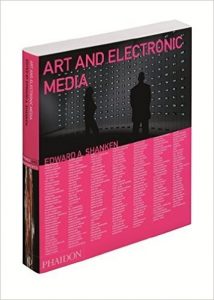

Weave Mirror assembles 768 motorized and laminated C-shaped prints along the surface of a picture plane that texturally mimics a homespun basket. A seemingly organic smoky portrait comes in focus to the sound made by the sculpture’s moving parts. Informed by traditions of both textile design and new media, the Weave Mirror paints a picture of viewers using a gradual rotation in greyscale value on each C-ring. A playful juxtaposition between the rustic and photographic, this sculpture is suspended from the ceiling. Its functional circuitry and wiring is visible behind the picture plane, exposing its craft.
Studies in Perception
The work resambles a piece of Kenneth Knowlon and Leon Harmon named Studies in Perception 1. In 1966, Knowlton and Leon Harmon were experimenting with photomosaic, creating large prints from collections small symbols or images. In Studies in Perception they created an image of a reclining nude (the dancer Deborah Hay), by scanning a photograph with a camera and converting the analog voltages to binary numbers which were assigned typographic symbols based on halftone densities. The resulting printouts are pixelated or granular versions of the original. Studies in Perception concists of different images. The set includes eerie facsimiled images of a nude woman, a rotary telephone, a gargoyle ocerlooking a city and a gradient-shaded square. These experiments demonstrate the power of suggestion and illustrate the human inclination to find familiar patterns. As with the perception of an impressionist or pointillist painting, the mind instantly converts the unintelligible collection of characters into recognizable image, reversing the original transformation into characters. These images could also be seen as precursors to virtual reality and the computer’s ability to fool the human eye – and eventually, other senses as well.
Introduction to ‘Electroworks’
According to the Introduction to ‘Electroworks’ (1979) Rozin can be seen as a copier. This term is introduced by Marilyn McCray in her article. In this article she writes about the rise of the copy machine as a tool to produce art in many different ways. As she argues, “artists have combined copier aesthetics with perspectives from almost every current field of artistic endaevour, including painting, design, sculpture, ceramics, printmaking, photography, video, film, animation, concpetual art, performance, poetry, artists’ books, correspondence art, and industrial graphic arts.’
Not like the usual copier described by Mc Cray, Rozin goes a step further with Weave Mirror. Instead of only making a copy he makes the copy machine and the copy with his Weave Mirror. The work makes functions as a copy machine since it copies the image that is presented. When the work copies the subject that is in front of it, it simultaneously becomes a copy of the subject. “The idea that a copying process is at odds with the standards of creativity” is expressed by this unique feature of the work.
About the Artist
Daniel Rozin is an
artist, educator and developer, working in the area of interactive
digital art. Born in Jerusalem and trained as an industrial designer
Rozin lives and works in New York. As an interactive artist Rozin
creates installations and sculptures that have the unique ability to
change and respond to the presence and point of view of the viewer. As
an educator, Rozin is the Resident Artist and Associate Art Professor at
ITP, Tisch School Of The Arts, NYU where he teaches such classes as:
“The World- Pixel by Pixel”, “Project Development Studio” and “Toy
Design Workshop”. As developer, Rozin owns Smoothware Design, a software
company that creates tools for the interactive art and multimedia
authoring community. In the work of Rozing the viewer becomes in many
cases the contents of the piece and in others the viewer is invited to
take an active role in the creation of the piece. Even though computers
are often used in Rozin’s work, they are seldom visible. The work of
Rozin has been exhibited widely and featured in publications such as The
New York Times, Wired, ID, Spectrum and USA Today.
